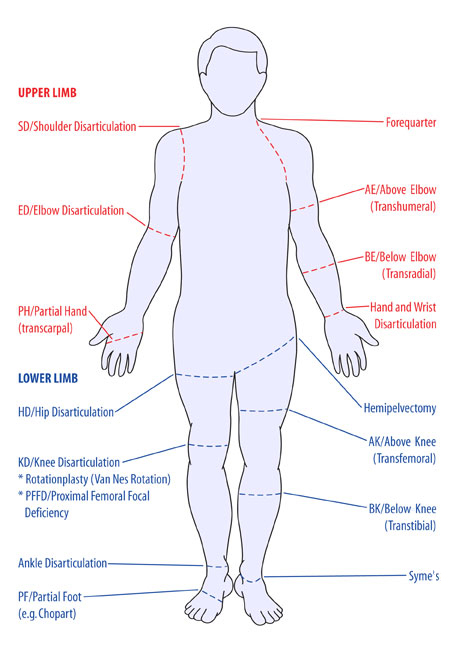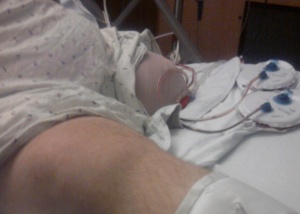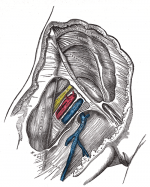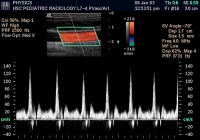Amputations: Difference between revisions
Niha Mulla (talk | contribs) No edit summary |
Niha Mulla (talk | contribs) No edit summary |
||
| Line 32: | Line 32: | ||
[[Image:Faqamp.jpg|frame|right|250x400px]] | [[Image:Faqamp.jpg|frame|right|250x400px]] | ||
== Levels of Amputation == | == Levels of Amputation == | ||
[[Image:Amputation.jpg|thumb|right|300px|Transfemoral Amputation]]Upper Limb | [[Image:Amputation.jpg|thumb|right|300px|Transfemoral Amputation]]'''Upper Limb''' | ||
*Forequarter | *Forequarter | ||
*Shoulder Disarticulation (SD) | *Shoulder Disarticulation (SD) | ||
| Line 40: | Line 40: | ||
*Hand/ Wrist Disarticulation | *Hand/ Wrist Disarticulation | ||
*Transcarpal (Partial Hand PH) | *Transcarpal (Partial Hand PH) | ||
*Transmetacarpal | |||
Lower Limb | |||
'''Lower Limb''' | |||
*Hemipelvectomy | *Hemipelvectomy | ||
*Hip Disarticulation (HP) | *Hip Disarticulation (HP) | ||
Revision as of 07:06, 13 November 2021
This article is currently under review and may not be up to date. Please come back soon to see the finished work! (13/11/2021)
Original Editor - The Open Physio project.
Top Contributors - Niha Mulla, Cornelia Barth, Laura Ritchie, Saeed Dokhnan, Admin, Rachael Lowe, Adam Vallely Farrell, Tony Lowe, WikiSysop, Kim Jackson, Shaimaa Eldib, Lauren Lopez, Tarina van der Stockt and Sai Kripa
Definition[edit | edit source]
Amputation is defined as surgical removal or loss of body part such as arms or limbs in part or full.
Prevalence[edit | edit source]
One million limb amputations are reported globally each year. And as of 2017, 57.7 million people across the globe have been living with traumatic amputation. Approximately 185,000 amputations occur in United States each year according to the amputee coalition. And also, as of April 2021, United states has over 2 million Americans living with amputation, and another 28 million at a risk of surgical amputation due to undelaying causes.
Data from Stanford Healthcare shows 49% rise in total number of amputations during the time of COVID-19 pandemic, during March 2020 to February 2021.
Causes of Amputations [edit | edit source]
- Severe infection with extensive tissue damage
- Gangrene
- Trauma resulting from accident or injury, such as crush or blast wound
- Congenital limb deficiency undergoing conversion amputation
- Congenital deformities of digits or limbs
- Congenital extra digits or limbs
- Necrosis or Necrotizing Fasciitis
- Cellulitis
- Peripheral Arterial Disease
- Frostbite
- Malignant/ cancerous tumor in bone or muscle of the limb e.g. sarcoma
Levels of Amputation[edit | edit source]
Upper Limb
- Forequarter
- Shoulder Disarticulation (SD)
- Transhumeral (Above Elbow AE)
- Elbow Disarticulation (ED)
- Transradial (Below Elbow BE)
- Hand/ Wrist Disarticulation
- Transcarpal (Partial Hand PH)
- Transmetacarpal
Lower Limb
- Hemipelvectomy
- Hip Disarticulation (HP)
- Transfemoral TF (Above Knee AKA)
- Knee Disarticulation (KD)
- Transtibial TT (Below Knee BKA)
- Ankle Disarticulation
- Symes
- Partial Foot PF (Chopart)
- Toe amputation
Surgical Procedures [edit | edit source]
Initially, the arterial and venous supply are ligated to prevent hemorrhage (bleeding). The muscles are transected and the bone is sawed through with an oscillating saw. Sharp and rough edges of the bone are filed down, skin and muscle flaps are then transposed over the stump.
Distal stabilisation of the muscles is recommended, allowing for effective muscle contraction and reduced atrophy. This in turn allows for a greater functional use of the stump and maintains soft tissue coverage of the remnant bone. Muscles should be attached under similar tension to normal physiological conditions.
- myodesis: the muscles and fascia are sutered directly to the distal residual bone for better prosthetic control
- myoplastic: suture to opposite muscle in the residual limb to to each other and to the periosteum or to the distal end of the cut bone for weight bearing purposes
Ideal Stump[edit | edit source]
- Skin flaps: skin should be mobile, sensation intact, no scars
- Muscles are divided 3 to 5 cm distal to the level of bone resection
- Nerves are gently pulled and cut cleanly, so that they retract well proximal to the bone level to reduce the complication of neuroma
Location of Pulses[edit | edit source]
- Foot pulse (Medial malleolus or dorsum of the foot)
- Popliteal (behind the knee)
- Femoral (within the femoral triangle)
- If a leg has been amputated because of gangrene, the remaining leg is examined for a puls
Special Investigations[edit | edit source]
- X-rays
- CT scan
- Angiogram (outlines blood vessels)
- Doppler ultrasound (occlusion of vessels)
- Venogram and arteriogram
- Radioactive dye injected into the blood
Arterial Insufficiency[edit | edit source]
- Surgery to improve circulation
- Bypass grafts (autogenous graft uses a vein to bypass the obstructed area)
- Synthetic grafts
Management[edit | edit source]
Please find below links to more detailed pages on the management of amputees
- Pain Management
- Pre-Fitting Management of the Patient with a Lower Limb Amputation
- Post-fitting Management
- Prosthetic Rehab
- High level Rehab
- Clinical Guidelines: Mental Health Amputees
Buerger’s Exercises[edit | edit source]
| [1] |
- Stimulates collateral blood flow in the patient’s leg
- It is performed for 20 min.
- The leg is elevated until the toes go white, then lowered, then level
- Repeat 2-3 times to improve collateral circulation
Connective Tissue Massage[edit | edit source]
Dynamic Stump Exercises[edit | edit source]
Balance and Gait Retraining[edit | edit source]
- Improve static and dynamic balance
- Use parallel bars, walking frame then Crutches (in that order)
- Therapist stands on the amputation side, using a belt around the patient’s waist to support
- Rest if the patient feels tired
| [2] |
Short Wave Diathermy (SWD)[edit | edit source]
Through the pelvis to warm the arteries (contraindicated in patients with arterial insufficiency because the warmth leads to increased metabolism, causing a greater demand for nutrients, which are not available)
Post-operative Care[edit | edit source]
- Maintain function in the remaining leg and stump to maintain peripheral circulation
- Maintain respiratory function (important with smokers and those patients under general anaesthesia)
- Prepare for mobility rehabilitation
Stump care[edit | edit source]
| [3] |
- For hygiene and skin care see handout on amputations
- A hip flexion contracture may develop because of elevation to reduce swelling
- Stump bandaging is done to ‘cone’ the stump, thereby preventing oedema, which occurs because there is no muscle pump and the stump hangs
- Swelling must be prevented to allow proper attachment of the prosthesis, and the prevention of pressure sores
- The stump sock is put on first, then the prosthesis
- The prosthesis must be cleaned and maintained (children who are still growing, grow out of their prostheses)
Mobility Aids[edit | edit source]
- The choice of mobility aids depends on the level of fitness, strength, balance skills of the individual:
- For bilateral lower limb amputees a wheelchair is often indicated (high energy expenditure during gait with prostheses)
Complications[edit | edit source]
Some of the most common complications associated with amputation include;
- Oedema
- Wounds and infection
- Pain (phantom limb)
- Muscle weakness and contractures
- Joint Instability
- Autonomic dysfunction
See here, for more detailed information on post-operative complications following an amputation.
References[edit | edit source]
- ↑ ladybessviernes, UDM PT Students. Buerger Allen's Exercise. Available from: http://www.youtube.com/watch?v=jQUFmOmX35o [last accessed 01/12/12]
- ↑ Clegstories. Clegstories. Gait Training with C-Leg®: Sitting Down and Standing Up. Available from: http://www.youtube.com/watch?v=_lBkrLZ4PGo [last accessed 08/12/12]
- ↑ Richard Major. Physiotherapy Stump or Residual Limb Wrapping. Available from: http://www.youtube.com/watch?v=T1SA_6hzTxQ[last accessed 08/12/12]










